
Speaker Design By RJB Enclosure DesignThere are several decisions to be made about the design of the enclosure and most of them are based on the specifications of the woofer/midbass driver. There are three main considerations when choosing an enclosure design for a woofer/midbass driver including enclosure configuration (sealed/ported), enclosure size and bass extension. You will also have to determine the best baffle layout to provide the best baffle diffraction response for the drivers and this is more critical for higher frequency drivers.T/S parametersThe first step in designing an enclosure for a driver is to get the T/S parameters and enter them into a box modelling program. It is best to measure the T/S parameters and base your design on those values but you can usually get by with using the manufacturer's data as long as the manufacturer is reliable. Sometimes I think it is better to use the manufacturer's data because it represents the performance after long term use and should be an average value for the batches that are sent out so if you base your design on these specs it will be less customized to your particular drivers but should work well with any batch of the same drivers as long as all the drivers aren't shifted to one side of the spectrum and the manufacturer's data is too far off. There are ways to determine what type of enclosure will work best just by looking at some of the T/S parameters but I'm going to make this a little less technical and let the enclosure simulation tool do all of the hard work. I usually use Unibox to simulate enclosures and have found that it offers the most data about the system and works great as long as you have Excel.In this section I'm going to assume that we have a driver picked out already and want to determine the best cabinet for it. The driver is the Vifa XT18 and the analysis in what follows will be based on designing an enclosure for this driver. I will explore the pros and cons of using this driver in various sized sealed and vented enclosures. Sealed or PortedIn order to tell if the driver is better suited to a sealed or ported enclosure you can use Unibox. Unibox indicates what type of enclosure the driver is suited for but I've found that it is better to just simulate the frequency response and determine if it will work well. Typically drivers with a higher Qts will be more suited to a sealed enclosure. When simulating the frequency response look at what size enclosure is required for each alignment and see if that meets your requirements. Then simulate the closed and vented versions and see if you can get a nice flat response. Some driver types that aren't suited for vented enclosures will have a peak in the response regardless of the box size and port tuning.Sealed enclosures have advantages and disadvantages. One of the advantages is you don't have to worry about port noise and the output from the driver is probably cleaner than the output coming from the port in the vented design. Also the sealed design will have a more shallow rolloff (12 dB/octave) below the box tuning frequency and a smaller enclosure is usually required. This shallower slope means that this alignment has less group delay. The sealed design also provides better back pressure on the driver at low frequencies so it can handle more power at those frequencies. The one negative aspect of a sealed enclosure is the -3dB frequency is higher than any other box type but the shallow slope rolloff does help. I tend to prefer vented enclosures primarily because they offer the lowest f3 of any of the alignments. However, a vented enclosure will require roughly double the volume of an optimal sealed enclosure for the same driver. Having a port can also introduce port noise if the diameter isn't large enough and the output coming out of a port is probably not as clean as the output of the driver in this range in a sealed design. At the port tuning frequency there is very little output from the driver and most of the output is coming from the port. This also reduces the driver excursion in this range which will increase the power handling at and just above the port tuning. However, below the port tuning there is very little back pressure resistance on the driver and the driver can more easily be pushed to its excursion limit. Also below the port tuning frequency the port output is out of phase with the driver output so this causes the slope of the response rolloff to be 24 dB/octave which is twice as steep as a sealed design. People often complain that ported designs don't have as tight and clean bass as sealed designs. I've found if the driver is good and the enclosure size and port tuning is done well that a vented design can sound quite good. A passive radiator is another option but I haven't used one yet so I'm not going to comment too much about it. A passive radiator design pretty much falls right in between the sealed and ported alignments. The typical box volume is greater than a sealed and smaller than a vented. The f3 is lower than a sealed and higher than a vented. I suppose the excursion limits also fall in between the other two alignments. I think if you made the box size and radiator tuning similar to that of an optimum ported enclosure that you might be able to get response performance close to that of a ported design. The advantage to using the passive radiator is that it has a cleaner output than the port and you don't have to worry about air noise. To tune a passive radiator you have to add mass to the cone. Passive radiator designs are attractive but you'll have to spend a little bit more money due to the cost of the passive radiator. Dual-chamber reflex (DCR) cabinets are a variation of a ported design. The DCR cabinet has two compartments inside. The larger compartment comprises 2/3 of the overall cabinet volume and houses the driver. The smaller compartment takes up the remaining 1/3 of volume. There are ports to the outside of the cabinet in each of the compartments. There is also a port of equal size connecting the two compartments internally. A DCR essentially gives you three port tunings, one at fb, one at roughly double fb and one just below fb. The DCR cabinet is the same size as a comparable ported cabinet. I simulated this design and built one too (Bandit) and concluded that there really aren't any advanages of this design over a comparable ported design. There is a slight reduction in excursion at the higher port tuning frequency but this is high enough in frequency to not be in a range where you are limited by excursion. There is a dip in the response at the higher port tuning frequency.There is no added bass extension and the f3 is the same as the comparable vented design. The one bonus is that there is more output between the base port tuning frequency and the high port tuning frequency when compared to the vented design. I built one and it doesn't sound bad but it is harder to tune and really doesn't offer any performance improvement over a vented design. There are other types of enclosures with the most common being the transimission line and other variants. I'm not going to discuss these other types of designs however since I have very little experience with them. Sealed DesignI will demonstrate the properties of various sealed enclosure alignments using the Vifa XT18WH driver in the examples. All of the simulation done for the sealed and vented responses were done using Unibox. The T/S parameters that Unibox requires for modeling a driver are as follows (the values are for the Vifa XT18WH taken from the manufacturer's specs).
So the first thing you must determine when designing a sealed enclosure is what Qtc you desire which is directly proportional to the size of the enclosure. Smaller enclosures will have a higher Qtc and larger enclosures will have a lower Qtc. Larger enclosures will also have a lower box resonant frequency (Fb). The Qtc of a sealed enclosure basically represents the Q of the low pass response of the driver in the sealed enclosure. A higher Q (greater than 0.8) response has a peak at the box tuning frequency and rolloff sooner and steeper. A lower Q (less than 0.6) response begins to decay higher in frequency but has a more gradual slope. The optimal case is a Qtc of 0.707 and this alignment gives you a flat response down to resonant frequency of the box, has the lowest f3 and has a slope that isn't as steep as the high Qtc design but it steeper than the low Qtc design. The plot below represents the performance of the Vifa XT18WH in a 11.3 liter cabinet which gives it an optimal Qtc of 0.707. 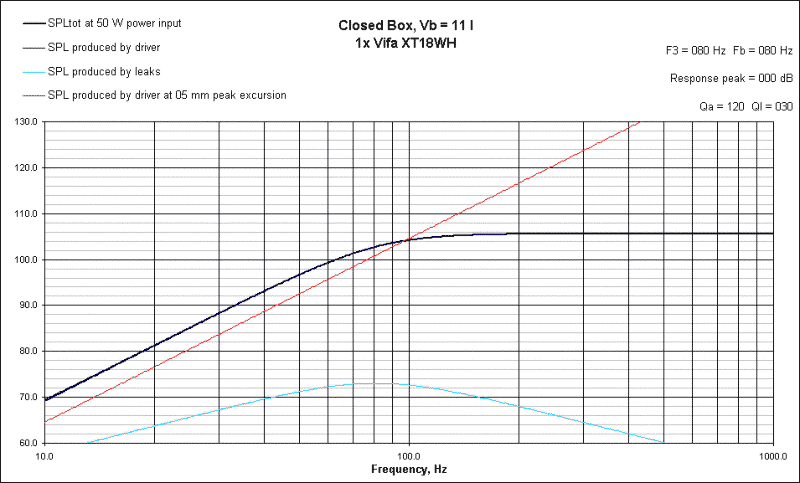
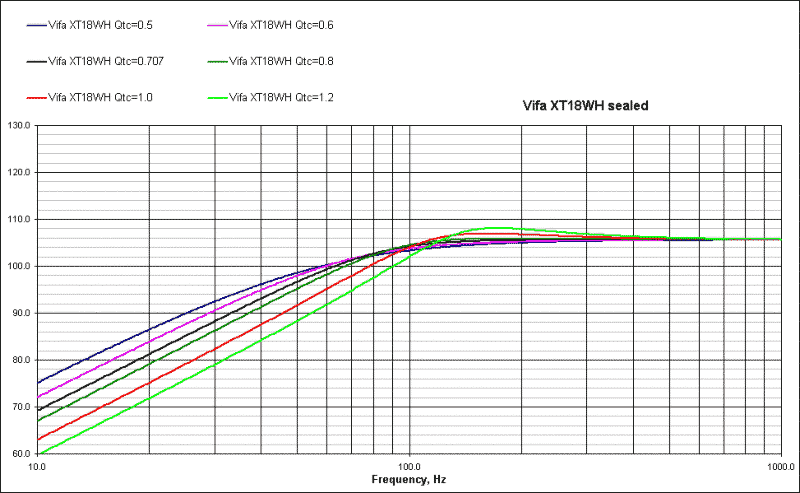
At Qtc=0.707 you get the deepest f3, flattest response and a compromise on the rolloff slope which is probably why it is so popular. However if you have a room that has a lot of gain in the bass region a shallower sloped rolloff might be better and provied a more natural bass sound. If this is the case then you would want to go with a lower Q enclosure. As shown in the plot the low Qtc responses begin to roll off sooner due to the lower box tuning frequency. However, the slope is more gradual so you end up getting better bass efficiency below the box tuning frequency. A lower Qtc enclosure can offer the greatest low bass extension but if the enclosure is too big your f3 will suffer because the driver will begin to roll off too high in frequency. Typically I like to use enclosures with Qtc values of 0.707 or lower and doubt that I would go higher than 0.8 unless I was using a Linkwitz transform. If I were going to use this driver in a sealed enclosure I would probably go with the 0.707 version because the power handling is pretty good and the f3 is the deepest. If I were to seal the ports of the Asterion design I would have a sealed Qtc of around 0.5 which is a bit low but still might integrate better with a subwoofer because the low pass filters on most subwoofers have 2nd order slopes which is much closer to the natural roll off of a sealed design as opposed to a vented design. I prefer to use vented enclosures most of the time because I prefer the deeper bass extension. However, sealed enclosures do have the advantage of better power handling at low frequencies. So for a home theater subwoofer which often has to produce sounds in the sub-20 Hz range I think a sealed enclosure would work better because in a vented sub once you get below the port tuning frequency (and it is usually above 20 Hz) there is very little damping on the driver and it will take a lot less power to push the driver past its excursion limits. Vented DesignFirst of all let me point out that there is a great writeup on the operation of ported enclosures including some animated graphics at http://www.hometheaterhifi.com/volume_5_2/cmilleressayporting.html A typical vented enclosure is just a low Q sealed enclosure with a port added to it in order to boost the frequencies just below the original box tuning frequency. At the port tuning frequency you get the maximum port SPL and the minimum driver SPL. Above and below this point there is contribution from both the port and the driver but as you get further away from the port frequency the port output drops. At and above the port tuning frequency the sound coming out of the port is in phase with the sound coming from the driver so they add constructively. Below the port tuning frequency the port sound is out of phase with the driver sound which causes the slope of the rolloff to be twice as steep as the rolloff of the driver alone. Also below the port tuning frequency the driver is "unloaded" meaning there is very little air pressure in the enclosure to keep the driver from moving freely and easily reaching its excursion limits with little power.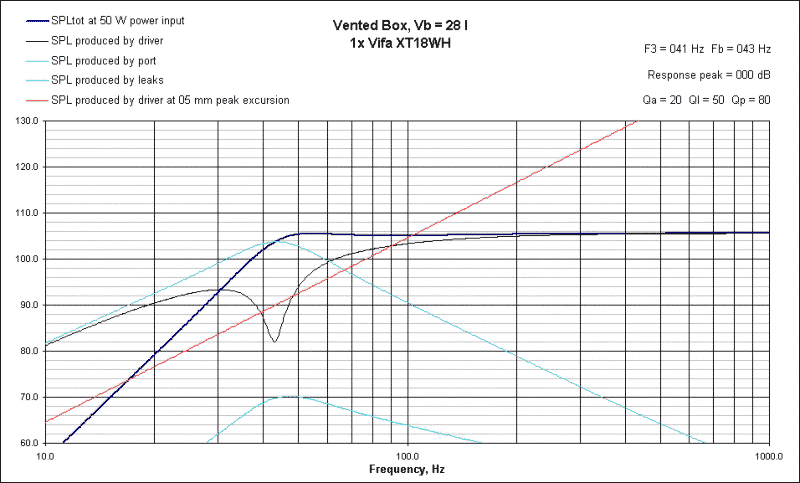
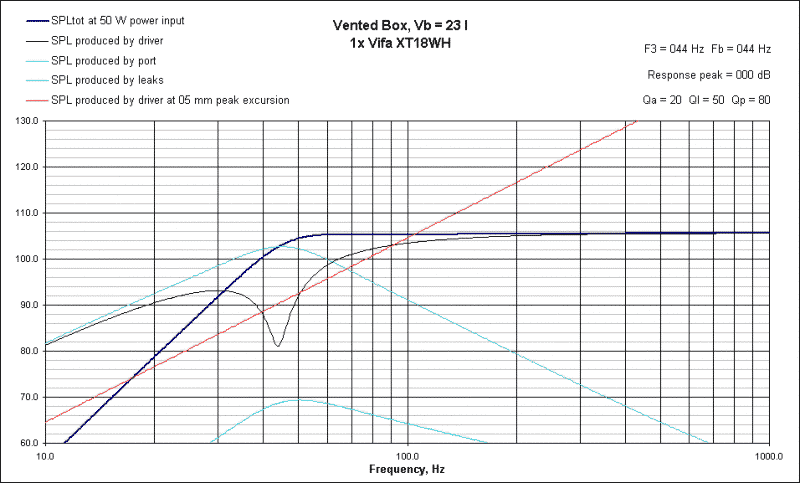
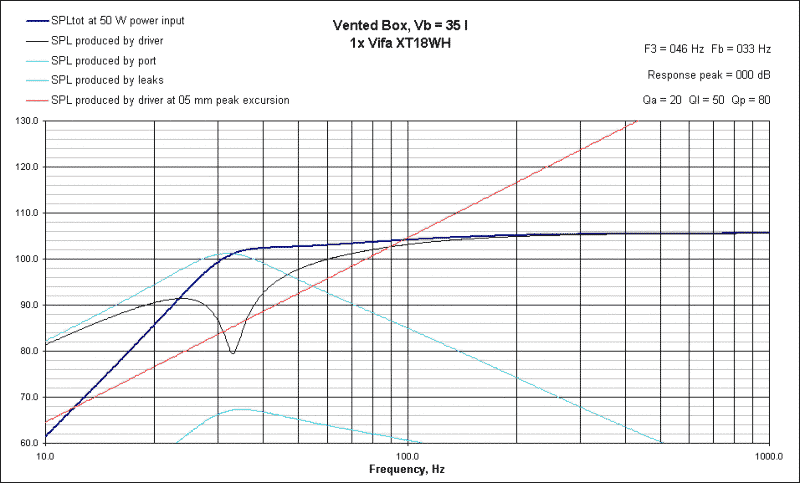
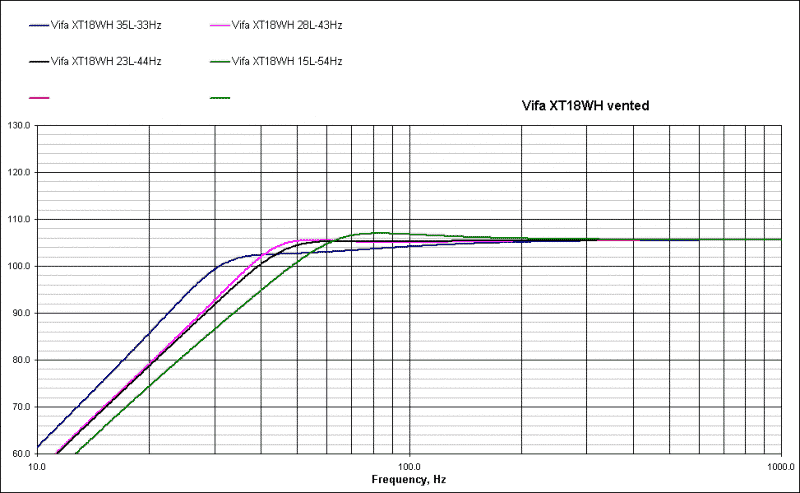
Vent DimensionsThe port diameter should be chosen to be large enough to limit the maximum air speed through the port. Therefore a larger driver with greater xmax will require a larger port diameter. Unibox provides plots of the port air speed for whatever port dimension you've chosen. I usually like to try to choose port diameters that lead to a nice port length that will fit within the cabinet. If you fix the port length, as you decrease the port diameter the port tuning frequency will go down. So if you have a port length that is too long you can reduce the port diameter in order to get the same tuning frequency with a shorter port. Flared ports can be used to try to reduce the amount of port air noise and in general a smaller diameter flared port offers similar performance to a larger non-flared port. So far in my projects I've used both 2" and 3" flared ports with 8" woofers. I've used 1.5" to 2.5" ports with 6.5" woofers and 1.375" to 2" ports with 5" drivers. If there are multiple drivers in the cabinet you can either use multiple ports each the ideal size for a single driver or increase the port diameter such that the new cross-sectional area is equal to the cross-sectional area of the multiple ports. I tend to think that a single port is better than multiple ports of the same cross-sectional area because the smaller ports will have greater air resistance but this isn't proven. If the length of the port gets too long then you can get pipe organ resonances which aren't good and can color the bass sound. I like to keep port lengths between 3" and 12" if possible but I haven't ported any drivers bigger than 8" and feel that large subwoofers are better in sealed cabinets due to the increased low frequency power handling.Passive Radiator DesignI have very little experience with passive radiator designs but I am going to post an example in order to compare the performance with the sealed and vented versions. A passive radiator is just like a driver without a motor so it is just a cone and suspension that moves from the air pressure generated by the driver in the enclosure. Passive radiators can be tuned by adding or mass to the cone. It is usually good to go with a passive radiator that is at least as big as the driver. I think most designers prefer to use a PR that is one size larger than the driver so for example use an 8" PR for a 6.5-7" driver and use a 10" PR for an 8" driver. If you use a PR that is the same size as the driver it is sometimes a good idea to use two PRs.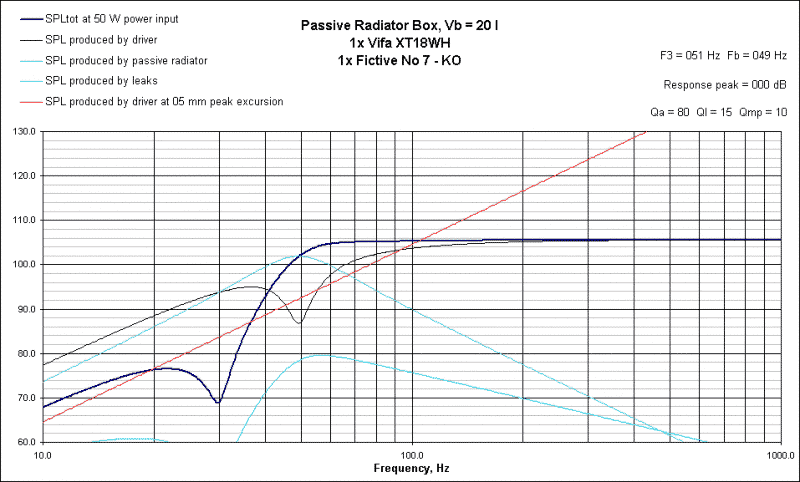
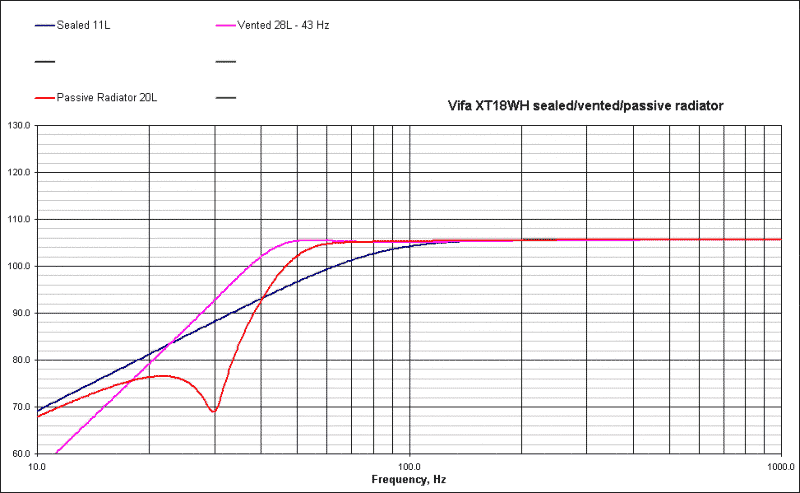
SummaryI think that just about covers everything that I can think of that deals with enclosure design. As you can see from my projects I tend to prefer ported enclosures for woofers and midwoofers. A midrange driver is rarely used with a ported enclosure but it has been done and the only explanation I can figure is that the designer need the the midrange response to be extended lower in frequency for the high pass filter to work properly. Personally, I prefer to use sealed or open back enclosures for the midrange. If I use sealed enclosure I try to make it extra large in order to reduce internal reflections or at least move them lower in frequency. The main reason why I like ported enclosures is because they have the lowest f3 and usually work well for bookshelf speakers or bass drivers in a three way design. Ported enclosures will also work for small subwoofers if they are dedicated to music use and not intended to be used with movies. For most subwoofers and especially home theater subs I prefer to use a sealed enclosure primarily for the extra power handling down low. A lot of movies have strong bass information below the typical subwoofer port tuning frequency. A ported sub would easily bottom out in this region while a sealed sub has more damping in this frequency range and won't reach its excursion limits as easily at the sacrifice of lower output. If the f3 is too high for a sealed sub design you can add a bit of bass boost in order to lower the f3 as long as the driver has the excursion capabilities. A lot of subwoofer plate amps have a built in bass boost of 6 dB at 30 Hz for this reason and others have adjustable bass boost frequencies and levels. If you want a smaller subwoofer with decent extension you can use a high Q sealed enclosure with a Linkwitz transform. The LT filters out the response peak and boosts the lower bass in order to get a lower Q in a smaller enclosure. This method works quite well but you need a driver with a lot of excursion and an amp with a lot of power. Some people like to build ported speakers with the intentions of plugging the ports if they want to hear a sealed version and you usually want to plug the ports of a speaker if you plan to use it with a subwoofer. Plugging the ports in a vented design will usually end up with a low Q sealed response because a ported enclosure is almost always larger than the optimal Q=0.707 sealed enclosure. |
